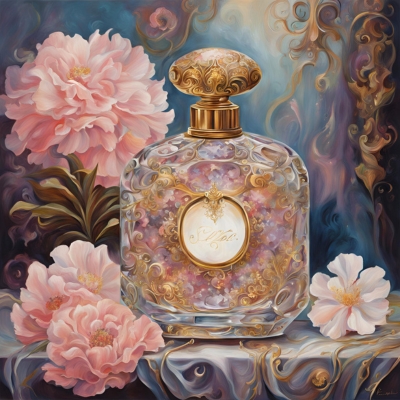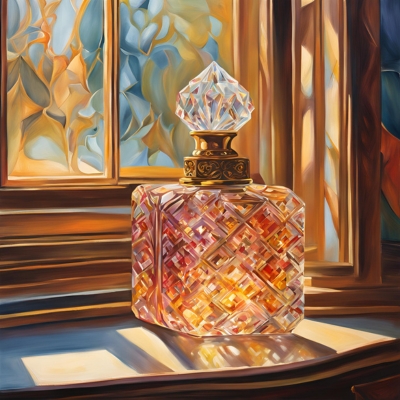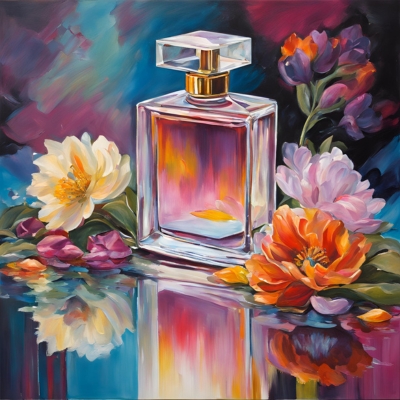From Concept to Bottle: How Perfume Is Made
A single fragrance can consist of over 100 different ingredients. This intricate blend demonstrates the complexity of the perfume manufacturing process and sets the stage for the artistry involved in crafting aromas that capture our emotions and memories.
Imagine walking through a sun-drenched field of lavender in Provence or sipping a rich espresso in a bustling café in Florence. Each of these experiences is uniquely tied to scent, highlighting how powerful fragrances are in evoking vivid memories. As you embark on this fragrance production guide, you will gain insight into the painstaking journey from concept to bottle: how perfume is made. You'll learn about the fragrance industry procedures that transform a simple idea into beautifully bottled scents that adorn your vanity.

The Art of Perfume Creation
Creating a captivating fragrance involves a deep understanding of various elements, starting with fragrance families. These categories serve as the foundation for both the categorization and marketing of scents. The artistry lies in how individual notes come together to evoke emotions and sensations. Understanding these families is essential for anyone looking to appreciate or create perfume.
Understanding Fragrance Families
Fragrance families, such as floral, oriental, woody, and fresh, encompass a broad range of scent characteristics. Each family possesses unique properties and notes that distinguish them from others. For example:
- Floral: Typically derived from flowers, these scents are often sweet and romantic.
- Oriental: These fragrances usually feature warm spices and rich resins, creating an exotic allure.
- Woody: Earthy and warm tones characterize this family, often featuring notes like sandalwood and cedar.
- Fresh: These scents can include citrus and aquatic notes, reflecting a clean and invigorating quality.
Recognizing these fragrance families aids in understanding the vast array of options available in the perfumery world.
The Role of a Perfumer
The role of a perfumer extends beyond mere composition; it combines artistry and science. A skilled perfumer uses various perfume crafting methods to blend essential oils, extracts, and other ingredients. This professional possesses in-depth knowledge of how different substances interact, which is vital for achieving harmonious fragrances. The process involves numerous fragrance creation steps, including initial trials, adjustments, and testing to refine the desired scent. Ultimately, a perfumer’s expertise transforms raw materials into captivating perfumes that tell a story through scent.
From Concept to Bottle: How Perfume Is Made
The journey of fragrance creation begins long before a bottle hits the shelves. It starts with an idea— the initial inspiration for fragrance creation. Often, this inspiration comes from a multitude of sources that can ignite the imagination of perfumers and brand visionaries alike.
The Initial Idea and Inspiration
Concept development in perfume involves a deep exploration of various themes, moods, and experiences. Nature often plays a pivotal role, with its diverse scents guiding creators toward unique compositions. From the freshness of a blooming garden to the earthiness of a rugged forest, the elements of nature provide endless ideas.
Art, in its many forms, serves as another wellspring of creativity. A striking painting or an evocative piece of music can evoke emotions that translate into olfactory experiences. Personal stories and memories frequently emerge as potent catalysts, prompting perfumers to capture a feeling or moment within a fragrance.
Market demands and trends also shape the initial inspirations, as brands seek to create scents that resonate with consumers. Research often involves analyzing successful fragrance launches to understand what captivates audiences. This creative phase integrates insights from case studies and interviews with fragrance marketers, ensuring concept development in perfume remains relevant and appealing.
The Perfume Manufacturing Process
The journey of creating a captivating perfume begins with a meticulous approach to ingredients sourcing and selection. Quality ingredients play a crucial role in shaping the fragrance's character, making the sourcing process essential for any perfume manufacturer.
Ingredients Sourcing and Selection
In the world of perfumery, sourcing high-quality raw materials can significantly impact the final fragrance profile. You will find that natural elements, such as flowers, fruits, and resins, are often sourced from specific regions known for their quality. Synthetic compounds are equally important, allowing for greater consistency and affordability in perfume manufacturing.
Consider the following practices during ingredients sourcing:
- Building relationships with trusted suppliers.
- Prioritizing sustainable and ethical sourcing.
- Regularly testing raw materials for purity and quality.
Distillation and Extraction Techniques
Once the ingredients have been sourced, the perfume extraction techniques come into play. Various distillation methods exist, with steam distillation being one of the most common. This technique uses steam to carry the aromatic compounds from the plant material, separating them for further use.
Alternative methods can also produce unique results:
- Solvent extraction: This process uses solvents to dissolve aromatic materials, effectively capturing a wider range of scents.
- Cold pressing: Mainly used for citrus oils, this method extracts essential oils from the fruit's peel without the need for heat.
Understanding these distillation methods and extraction techniques enhances your appreciation for the complexity and artistry involved in the perfume manufacturing process. Each method impacts the scent profile, contributing to the final result you experience.

Fragrance Creation Steps
Understanding the essential stages in fragrance creation is crucial for any aspiring perfumer. The process involves careful blending essential oils to achieve a harmonious scent profile. This includes balancing the different fragrance notes—top, middle, and base—to create a well-rounded perfume. Alongside blending, you will engage in creating fragrance samples, a vital step that allows for testing and refining before final production.
Blending Essential Oils
In blending essential oils, you will start by selecting your base oils, which form the foundation of your scent. This process involves layering the components while considering their interactions. Each note contributes to the overall fragrance, influencing longevity and character. Utilize a precise formula to ensure consistency in your blends, leveraging techniques from various perfume crafting methods.
Creating Fragrance Samples
The next key step is creating fragrance samples. This involves mixing small quantities of your blended oils to produce samples that can be tested for scent accuracy and appeal. Evaluate these samples under different conditions to see how they perform over time. Feedback from trusted individuals will enhance your understanding of how others perceive your creation, guiding you through the necessary iterations.
Perfume Formulation Stages
In the journey of crafting a unique fragrance, the perfume formulation stages play a pivotal role. Transitioning from an initial blend to a commercially viable perfume requires testing and refinement, ensuring that every note contributes to the intended olfactory experience.
Testing and Refinement
Testing perfume samples is essential to the formulation process. Perfume creators often utilize focus groups to assess the fragrance's appeal. This sensory evaluation involves feedback on various aspects such as scent longevity, strength, and overall experience. The input gathered can lead to adjustments in the composition, refining the blend to meet consumer satisfaction.
Storage and Maturation Processes
The maturation of a fragrance occurs during the storage phases. Applying proper storage techniques for fragrance ensures that the scent develops harmoniously over time. Ideal conditions include maintaining a stable temperature and minimizing exposure to light. This careful aging allows the fragrance components to integrate fully, creating a more rounded and nuanced scent profile, which enhances its market readiness.
Scent Development Techniques
In the world of perfumery, innovating unique scents requires a mastery of various scent development techniques. You will encounter methods such as molecular gastronomy, which explores the science behind scent combinations. This approach allows perfumers to meticulously craft fragrances with unexpected elements.
Scent layering represents another effective technique utilized in the fragrance industry. By combining multiple scent notes, you can achieve a rich and complex olfactory experience. This method not only enhances the fragrance but also enables you to tailor the perfume to individual preferences.
Olfactory technology plays a key role in modern perfume crafting methods. Utilizing advanced testing equipment allows perfumers to analyze ingredient interactions, ensuring optimal harmony in the final product. As you delve into these fragrance industry best practices, you'll notice how technology shapes and refines traditional methods.
Keeping abreast of contemporary innovations in scent development fosters creativity. By embracing new techniques, you expand the horizons of fragrance possibilities, resulting in captivating and memorable scents. The evolution of these practices ultimately leads to an enriched experience for consumers and a vibrant future for the fragrance industry.

The journey of perfume creation is a captivating exploration of art and science, intricately woven from concept to bottle. Each stage, from the initial idea to the final composition, plays a crucial role in crafting a fragrance that resonates with your senses. Understanding this perfume production guide enriches your appreciation for the complexities involved in the history of perfumery, revealing the fine balance of creativity and technique that defines expert perfumers.
As you reflect on the detailed process outlined in this article, consider the emerging trends shaping the fragrance industry. Sustainability continues to be a significant focus, with brands innovating to incorporate eco-friendly practices in their production methods. Furthermore, the rise of personalized scents indicates a shift towards more tailored experiences, allowing individuals to express their unique identities through fragrance.
Staying informed about these developments ensures you remain engaged and attuned to the evolving world of scents. By appreciating the artistry and craftsmanship of perfumery, you can enhance your experience and connection to the fragrances you choose, further elevating your understanding of this timeless craft.
Related Articles
The Best Perfumes to Give as GiftsThe Rise of Celebrity Fragrances
How to Choose the Perfect Perfume
DIY Perfume: Create Your Signature Scent
Eco-Friendly Perfumes
Shop Perfumes on Amazon
